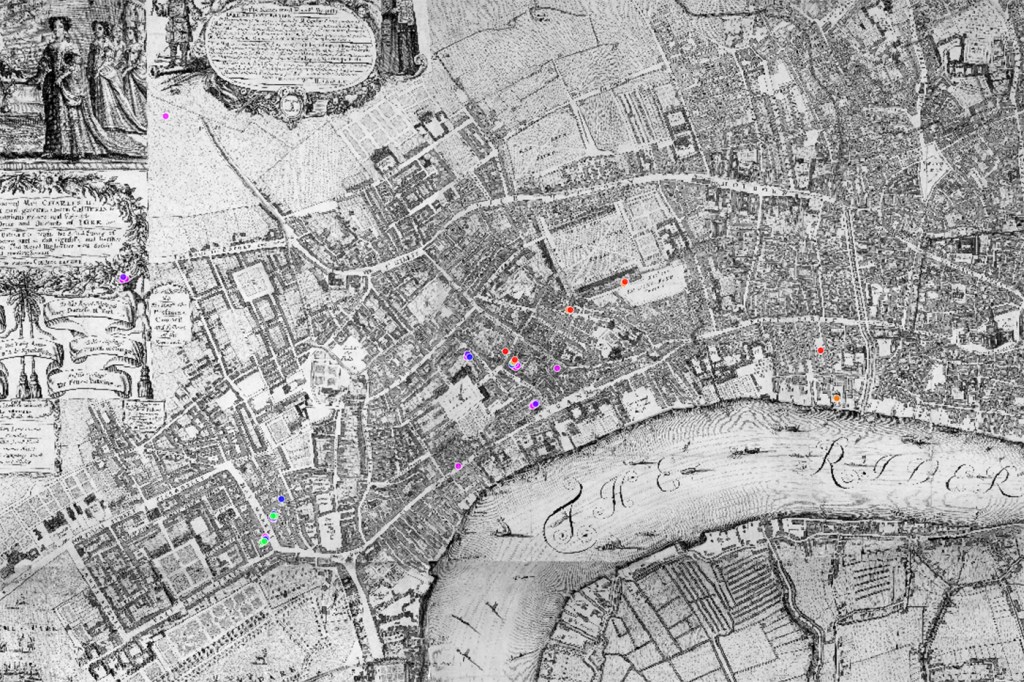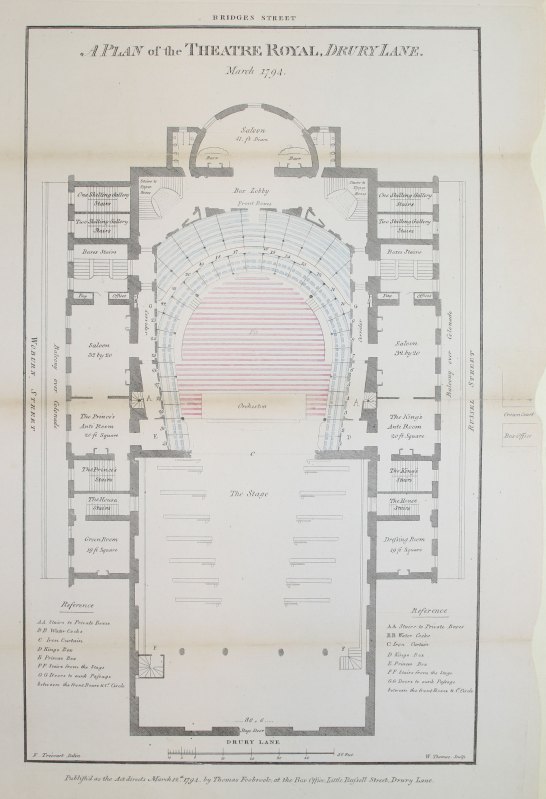London’s underground theater scene takes center stage in new Northeastern mapping project

LONDON — On a January night in 1749, a crowd of Londoners took their seats at the Theatre Royal Haymarket to see something truly remarkable.
That night, a man was slated to take the stage, along with an empty wine bottle. According to advertisements, he would then compress his entire body into the bottle and, once inside, start singing.
Of course, this didn’t happen. And while it was great fun for the Duke of Montagu to mislead London’s theatergoers, they didn’t agree. Once the audience realized they’d been duped, they rioted, destroying the interior of the theater and starting a bonfire outside.

This is just one of the many stories that Northeastern University students in London have uncovered in a new digital humanities project, The Origins of West End Theatre, that maps the underground theater world in London’s West End after the Restoration.
Funded by the NULab for Texts, Maps and Networks, the interactive map presents information about 45 different theaters that were active from 1660 to 1812. In doing so, it shines new light on a largely forgotten — but significant — part of London’s theater history.
It’s a historical period that is shrouded in misconception, says Peter Maber, professor of English and the principal investigator on the project.
After the Restoration of the monarchy in England in 1660, only two patents were granted by Charles II for theater, meaning only two theaters had the royal stamp of approval to put on performances: Covent Garden and Drury Lane.
But this doesn’t mean theater wasn’t happening elsewhere.
“There’s a very straightforward narrative that often gets told,” says Maber, that only two theaters were operating during this time. “That’s just not the case; it’s vastly more complicated than this.”
“Over the century, you see all of these smaller, peripheral venues pop up,” says Miriam Cruz, who just finished her degree in English and creative writing, and who worked on the project.
In other words, theater went underground. Many different spaces were used, including open air, courtyards, private buildings and even tennis courts, to put on performances. “There’s actually a really rich theater life going on, and that just isn’t captured by the standard history,” says Maber.
Maber, who teaches the history of London theater at Northeastern University — London, decided to use digital mapping to present this clandestine theater world. He enlisted five student researchers from the English and history departments for the project, which began in March and which he says has been “an absolute joy to work on.”
The project didn’t come without challenges. It took a combination of online and in-person research to learn more about the theaters of London.
“This information, it’s very scattered,” Cruz says, noting that theaters often change names and places, burned down, were redesigned, and were rebuilt. “They’re kind of confusing to track.”
But what they’ve found has painted a clearer picture of what theater looked like in this time — in stunning detail. In trips to the National Archives, and in wandering around London scoping out locations, the students found original plans of what the architects drew up, including precise dimensions of stages. They’ve discovered who owned and operated each theater during this time, and which actors were performing in which plays.
There’s actually a really rich theater life going on, and that just isn’t captured by the standard history.
Peter Maber, professor of English at Northeastern University
Naturally, some juicy tidbits have turned up, including the role of women. As of 1660, women were allowed to appear on stage (according to Maber, the story goes that Charles II saw women actors in France and was inspired to allow it in England).
Nell Gwyn, mistress of King Charles II, was one of the first. But women were involved in other ways, too — as patronesses, for example. It was during this time, as well, that the Royal Theatre at Covent Garden had its first female owner, Elizabeth Branson. Also an actress, she inherited her husband’s portion of the theater when he died.
“It’s sort of unveiling women in new economic and cultural positions and shaping what is becoming a really meaningful sector and space in the city,” Cruz says.
Duchess Jane Gordon, whom Cruz calls a “scandalous figure in London society at the end of the 18th century,” was a patroness who produced a spoken-word drama, which wasn’t allowed at the time.
These “personalities,” Cruz says, bring the theater scene to life.
“The drama isn’t just onstage,” she says.
Students researching different theaters have discovered affairs that were happening between actors. They’ve learned more about Charles Macklin, an actor who accidentally killed a man by stabbing him in a fight over a wig at Theatre Royal, Drury Lane. He got off in the court case, Cruz says, because he said, “who knows what a man will do in a passion.”
They learned that producer John Rich managed both the Theatre Royal Covent Garden and Lincoln’s Inn Fields Theatre at the same time, using the same company of actors. This meant that the actors had to sprint between theaters to perform at both on the same day.
They’ve also explored how theaters adapted to the legal restrictions on theater, in turn creating a new genre that persists to this day.
In 1737, the licensing law introduced a loophole: the two patents given out were only for spoken-word performances. To get around the spoken-word restrictions, Cruz says, other, unofficial theaters would perform melodramas and musicals. “That is sort of the birth of musical theater and it develops into the 19th century and becomes its own legitimate art form,” she says.
Maber describes theater at this time as “kind of an over-the-top, very heightened drama with musical accompaniment,” similar, he says, to “Les Miserables.” John Gay’s “The Beggar’s Opera,” what some call the first-ever musical, was performed during this time.
They’re asking bigger questions as well, like what constitutes a theater. Does an impromptu performance on a tennis court, for example, count? “As soon as you’re looking outside the patented theaters, it becomes much more fluid what theater and performance are,” Cruz says. “It’s really a very fluid concept.”
Plays and performances evolve with the times, and the spaces allowed. As the audience got further away from the stage, the fourth wall developed.
Now, all this is on display for the public to view in a concise, accessible map, which, Maber says, is just the beginning.
In the future, Maber hopes to expand the project into the 19th century, when, he says, there was “an explosion” of new theaters, and also to explore the East End, including the vicinity of Northeastern’s London campus. He would like to explore creating visualizations of the theaters using the precise blueprints they’ve discovered.
The team may go so far as to organize performances that mimic what audiences would have seen at the time, in spaces that resemble the theaters.
In this way, Maber says, they can take the project one step further — they can bring the plays of the time “back to life.”






